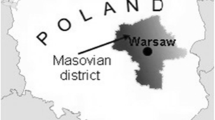Abstract
The concentrations of calcium, magnesium, zinc, copper, lead, and cadmium were determined in scalp hair samples from a group of 12 autistic children and a group of 12 nonautistic control children. The only statistically significant difference between median concentrations of minerals in the hair from the two groups was a 62% decrease in the concentration of cadmium in the hair of autistic children. This decrease was probably not physiologically significant. The nutrient intake of autistic children as a group was found to be adequate and typical of well-fed American children. It was concluded that the children in neither the autistic nor the nonautistic control group showed evidence of toxicity or deficiency of the minerals or nutrients studied, but because of food idiosyncracies nutrient intake should be monitored.
Similar content being viewed by others
References
Campbell, M., Petti, T. A., Green, W. H., Cohen, I. L., Geniesser, N. B., & David, R. Some physical parameters of young autistic children.Journal of the American Academy of Child Psychiatry, 1980,19, 193–212.
Cohen, D. J., Johnson, W. T., & Caparulo, B. K. Pica and elevated blood lead levels in autistic and atypical children.American Journal of Diseases of Children, 1976,130, 47–48.
DeMyer, M. K., Ward, S. D., & Lintzenich, J. Comparison of macronutrients in the diets of psychotic and normal children.Archives of General Psychiatry, 1968,18, 585–590.
Downie, N. M., & Heath, R. W. Distribution-free statistical tests. InBasic statistical methods (4th ed.). New York: Harper & Row, 1974.
Emmel, R. H., Sotera, J. J., & Stux, R. L. Standard conditions for flame operation. InAtomic absorption methods manual (Vol. 1). Wilmington, Massachusetts: Instrumentation Laboratory, 1977.
Friberg, L., Piscator, M., Nordberg, G. F., & Kjellstrom, T.Cadmium in the environment (2nd ed.). Cleveland: CRC Press, 1974.
Goodwin, M. S., Cowen, M. A., & Goodwin, T. C. Malabsorption and cerebral dysfunction: A multivariate and comparative study of autistic children.Journal of Autism and Childhood Schizophrenia, 1971,1, 48–62.
Mahanand, D., Wypych, M. K., & Calcagno, P. L. Serum zinc and copper levels in autistic patients and matched controls. In M. Coleman (Ed.).The autistic syndromes. New York: North-Holland, 1976.
McCarthy, D. M., & Coleman, M. Response of intestinal mucosa to gluten challenge in autistic subjects.Lancet, 1979,2(8148), 877–878.
Moss, N., & Boverman, H. Megavitamin therapy for autistic children.American Journal of Psychiatry, 1978,135(11), 1425.
National Research Council.Recommended dietary allowances. Washington, D.C.: National Academy of Sciences, 1980.
O'Banion, D., Armstrong, B., Cummings, R. A., & Stange, J. Disruptive behavior: A dietary approach.Journal of Autism and Childhood Schizophrenia, 1978,8, 325–337.
Page, L., & Friend, B. Level of use of sugars in the United States. In H. L. Sipple & K. W. McNutt (Eds.),Sugars in nutrition. New York: Academic Press, 1974.
Pihl, R. O., & Parkes, M. Hair element content in learning disabled children.Science, 1977,198, 204–206.
Rimland, B. High-dosage levels of certain vitamins in the treatment of children with severe mental disorders. In D. Hawkins & L. Pauling (Eds.),Orthomolecular psychiatry. San Francisco: W. H. Freeman, 1973.
Rimland, B., Callaway, E., & Dreyfus, P. The effect of high doses of vitamin B6 on autistic children: A double blind crossover study.American Journal of Psychiatry, 1978,135 (4), 472–475.
Ritvo, E. R., & Freeman, B. J.Definition of the syndrome of autism. Albany: National Society for Autistic Children, 1977.
Shearer, T. R., DeSart, D. F., Isman, R. E., Sanzi-Schaedel, S. M., & Pickles, T. M. Sugar content of vending machine foods.Journal of the Oregon Dental Association, 1980,49(4), 32–34.
Shearer, T. R., Elmer, K. L., Brown, A. C., & Wyss, C. Computer facilitated dietary analysis.Journal of the Oregon Dental Association, 1980,49(3), 29–31.
Underwood, E. J.Trace elements in human and animal nutrition (4th ed.). New York: Academic Press, 1977.
U.S. Department of Agriculture. A daily food guide. InConsumers all. The yearbook of agriculture. Washington, D.C.: U.S. Government Printing Office, 1965.
Valkovic, V.Trace elements in the human hair (Vol. 14). New York: Garland STPM Press, 1977.
Wing, L.Early childhood autism (2nd ed.). New York: Pergamon Press, 1976.




